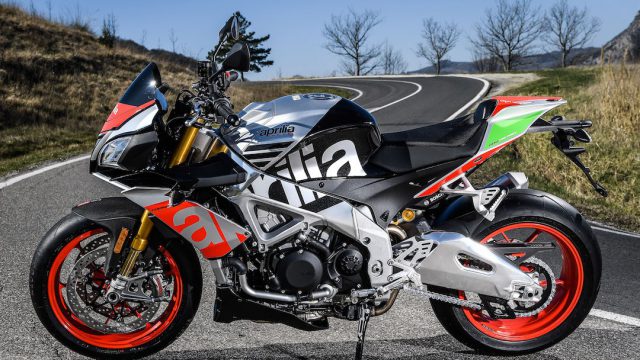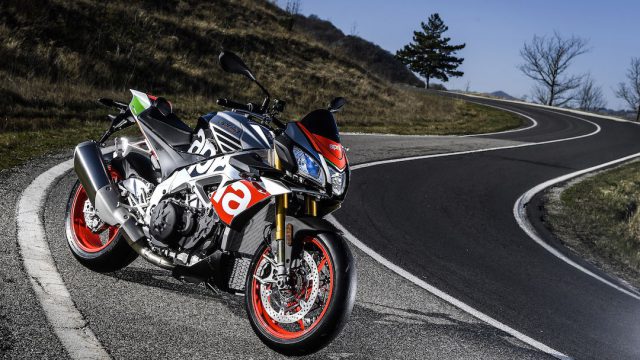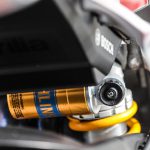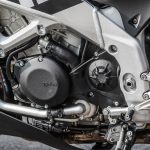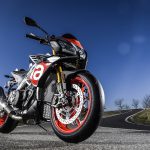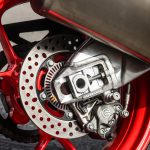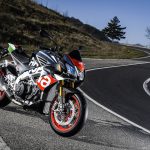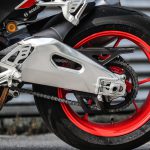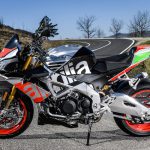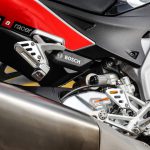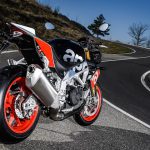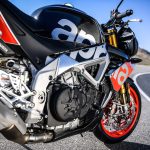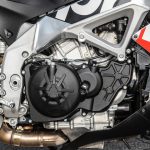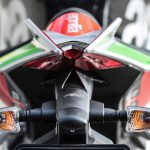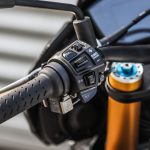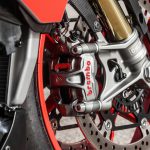A technical view on the new Aprilia Tuono V4 1100 Factory
In redeveloping its category-topping Tuono V4 1100 to achieve Euro 4 compliance, Aprilia has also incorporated a range of updates for 2017, particularly including more advanced electronics.
For in achieving the same 175bhp/129kW at 11,000 rpm as the outgoing Euro 3 model, with peak torque of 121Nm at 9,000 rpm also unchanged, Aprilia’s engineers led by Ing. Roberto Calò have had to work on a myriad small details to tick al the Euro 4 boxes without sacrificing any performance whatsoever on the company’s best-selling sports model. Indeed, they’ve even raised the redline on the overbored 81 x 52.3 mm 1,078cc engine by 500 rpm to 12,500 rpm, to deliver a still broader spread of power and torque.
Read the Aprilia Tuono V4 1100 Factory Review
The three-time World Superbike title-winning 65º V4 motor’s essential architecture remains unchanged, as designed a decade ago by noted Italian progettista Ing. Claudio Lombardi, the former Ferrari F1 designer and creator of the fabulous Lancia Delta Integrale which won four World Rally titles between 1987 and 1992. This sees the upper half of the horizontally-split crankcase incorporating the watercooled cylinders cast integrally for greater stiffness, with separate Nikasil-lined aluminium liners, and an optimised ventilation system aimed at reducing pumping losses caused by air pressure inside the crankcase. The lower crankcase half incorporates a magnesium sump casting internally designed to optimise lubrication at full lean, or under hard acceleration or braking – and especially when wheelying, if you switch off the electronic AWC/anti-wheelie control, which for 2017 is now adjustable on the fly, without having to shut the throttle. Ing. Calò says it also operates more precisely, because the system’s inertial platform has been repositioned.
The Tuono’s forged pistons – whose gudgeon pins now feature a DLC coating for improved durability, as on the new RSV4 – sit on Pankl forged steel conrods (whose little ends have now been given a surface honing treatment) running on a plain-bearing forged one-piece crankshaft. To keep the twin-spar chassis as narrow as possible – an issue essentially dictated by the width of the cylinder heads, where the frame spars wrap around them – Aprilia employs a modular camdrive arrangement, with a separate chain for each twin-cylinder block driven via an idler gear running off the crank, which in turn drives the inlet camshaft for each dohc cylinder head. Another pair of idler gears then drives the exhaust camshaft, permitting a narrow 250mm width across the top of the engine, which is actually slimmer than the old RSV1000 V-twin.
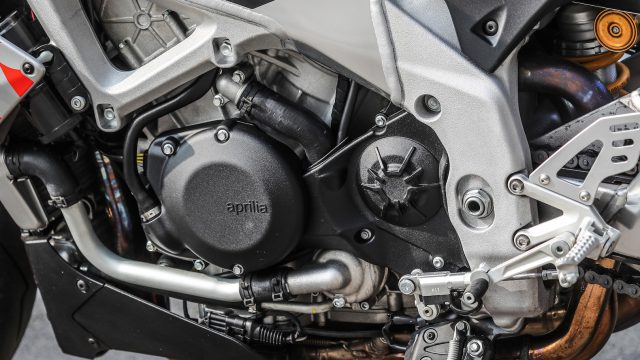
The Tuono’s 1078cc motor now features the same uprated, re-ported cylinder heads as the RSV4, so that the four-valve combustion chambers are now CNC-machined from solid rather than cast in as before on the 1100 motor. While the pairs of 32mm titanium inlet and 28mm nimonic steel exhaust valves for each cylinder are unchanged, sitting at an ultra-flat 22° included angle to each other, the valve timing is altered from the RSV4 via different cam profiles, to regain the torque lost in meeting Euro 4. However, the four 48mm Marelli throttle bodies are each fitted with single injectors positioned upstream of the throttle butterfly, not dual ones as on the Superbike. The variable intake system of the RSV4 has also been jettisoned in favour of attaching all four intake trumpets in a fixed position to the throttle bodies, and these are 20mm longer to fatten low-rpm pickup and midrange performance. But as on the RSV4, Euro 4-compliant engine management is entrusted to a new, yet more powerful Magneti Marelli ECU, though Aprilia is still as ever responsible for calibration of the software in-house. The RBW/ride-by-wire throttle system uses a pair of servo motors – one for each bank of cylinders – to operate the throttle butterflies, which thus allows the fuelling for each cylinder bank to be managed independently. Additionally, a choice of three different full-power throttle maps is offered via a switch on the handlebar, labelled Race, Track and Sport – so, no reduced-power Rain mode, and no Custom map that you can concoct yourself, as on some other brands. But you can now switch between modes on the fly, without closing the throttle, with the settings displayed on the new, very clear, full colour 4.3in TFT dash with two selectable screen pages – Road and Race, both with night and day backlighting.
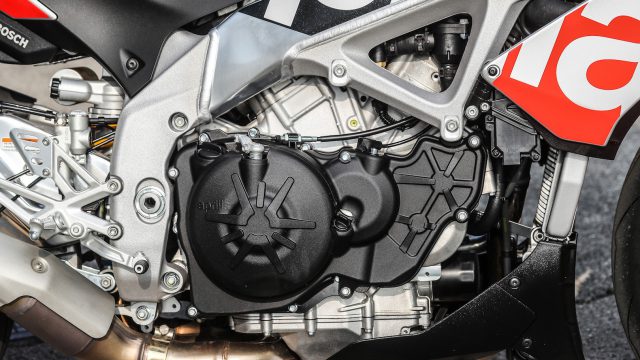
The Tuono 1100’s six-speed side-loading cassette-type gearbox uses straight-cut primary gears, and is matched to a ramp-type oil-bath slipper clutch. The gearbox has the same choice of ratios as on the RSV4 to reflect the engine’s power and torque, and features a lightened mainshaft, layshaft and primary drive plus narrower gear pinions for a total weight saving of 0.45kg versus the old V4 motor. The single counterbalancer needed to iron out the vibration caused by the narrow 65º cylinder angle is mounted low down in front of the front cylinder block, and gear-driven directly off the crank, plus it’s also been reweighted compared to the RSV4, at the cost of a 3bhp power loss in driving it, say Aprilia engineers. The Tuono’s revised 4-2-1 stainless steel exhaust system now carries twin oxygen sensors and a larger three-way catalyst to meet Euro 4 norms, as well as a reed valve which admits air to the system when the engine is cold, to help counter start-up pollution issues. In addition, as on the RSV4 there’s an ECU-controlled exhaust powervalve operated via stepper motors to further optimise bottom end performance, as well as to cut down on noise in urban situations. Doesn’t stop it sounding super-horny when you drive out of a street corner at low revs, though…!
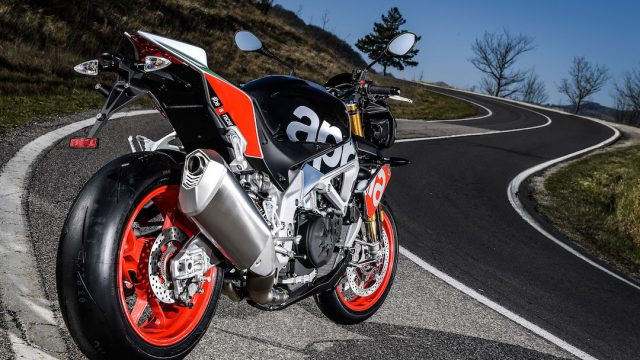
This 1078cc V4 engine is installed in an unchanged version of the RSV4’s multi-adjustable twin-spar frame composed of polished aluminium pressings and castings to form a light but stiff chassis weighing just 10.1kg, plus another 5.1kg for the asymmetric swingarm pivoting in it. This is 3mm longer than before, in order to help improve traction and combat wheelies via the slightly longer 1450mm wheelbase, and as on the RSV4, the Tuono’s motor is positioned 5mm lower than before within the adjustable frame mountings, for extra stability in harnessing the meaty motor’s performance. Seat height is unchanged at 825mm.
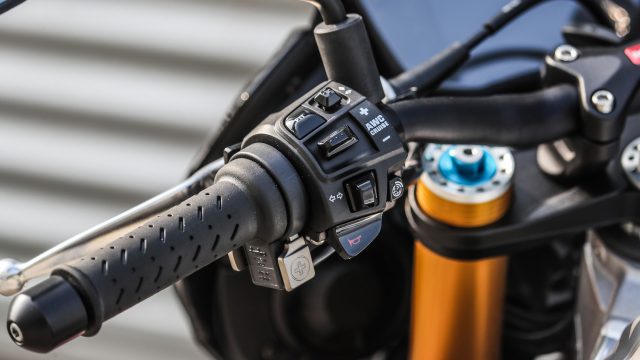
Each variant of the Tuono, RR and Factory, has fully adjustable suspension via a 43mm upside down fork set at an angle of 24.7° (reduced from 25.1º on the original Tuono), with a much less rangy 99.7mm of trail (107.4mm before), thanks to the offset on the tripleclamps being increased from 30mm to 35mm. On the Tuono RR this fork comes from Sachs, while the Factory gets an 0.4kg lighter Öhlins NIX fork with 28-click rebound damping adjustment on the right leg and ditto compression on the left, with the forks on both models offering a slightly increased 120mm of travel (was 110mm) for 2017. There’s the same split of manufacturers at the rear, where their fully adjustable monoshocks both give 130mm of travel. Brakes on both versions sees Brembo’s benchmark radially-mounted four-piston Monoblock one-piece M4.32 brake calipers now gripping 10mm larger 330mm twin floating front discs that are also 0.5mm thicker (now 5mm) via a radial master cylinder (finally!). These are mounted on both variants on a 3.50in cast aluminium wheel (so, not forged on the Factory, as on the RSV4 RF) with a distinctive triple-split spoke design. Its 6.00in rear counterpart carries a 220mm disc with two-piston caliper, together helping stop a claimed dry weight for either version of the Tuono 1100 of 186.5kg, 2.5kg heavier than before thanks to the bigger catalyst needed for Euro 4, but still evenly split 50/50 front to rear. Tyre-wise, the Factory is shod with Pirelli Diablo Supercorsa rubber, with a 200/55 rear cover as standard, though 190/50 and 190/55 options are available/approved. The Tuono V4 RR comes with the new Pirelli Diablo Rosso III tyres, with a 190/55 rear.
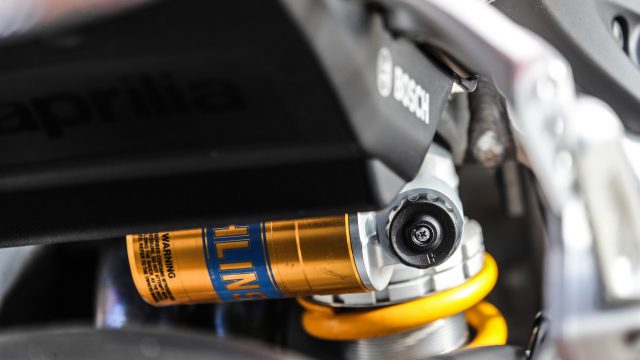
The Tuono 1100’s frame-mounted half-fairing has been wind tunnel-redesigned to deliver protection while minimising drag, and incorporates a dedicated version of Aprilia’s trademark triple headlight styling, complete with LED headlamps. The RR model costing Euro 16,040 in Italy OTR/on the road including 22% local tax, is available in either Assen Black (no, I have no idea why it’s called that, unless it’s because of how often its rains there in the middle of a MotoGP or WSBK race!) or Portimao Grey (can Aprilia expect a complaint from the Portuguese Tourist Board?), while the Factory version costing Euro 18,190 OTR only comes in what Aprilia terms its Superpole tricolore livery derived from its Superbike racer.
Aprilia has always led the world with its electronic rider aids programmes, and the updated version of its benchmark APRC electronics package is included as standard on both versions of the latest Tuono 1100, now incorporating a pitch sensor as well as the previous model’s lean and yaw. In case you need reminding, the APRC includes the three-stage RBW digital throttle offering those three distinct riding modes, and eight-level ATC/ Aprilia Traction Control, three-stage AWC/anti-wheelie control. Both these systems can now be adjusted or even deactivated on the move via a finger and thumb paddle system on the left ‘bar without having to close the throttle, and the AWC has a new algorithm designed to improve its performance, says Ing. Calò. Three-stage launch control (‘for use on track only’, says Aprilia – but I can confirm that it comes in useful for Stoplight GPs!) is also featured as before, but with new operating strategies to make it more effective. Other electronic updates include non-adjustable engine braking control as well as the electronic quickshifter – now with an autoblipper for clutchless downshifts as well – and a recalibration programme which detects the type and make of tyres fitted, and adjusts these electronic programmes accordingly. Cruise control is now fitted for the first time, to help while away those boring miles riding on speed camera-infested highways between your two favourite stretches of Racer Road, and there’s now also a speed limiter function – aka ‘pit lane limiter’ – to help you preserve your licence in passing those same speed cameras.

In addition, for 2017 Aprilia has now followed Ducati and BMW in fitting the switchable advanced multimap Bosch 9.1MP Cornering ABS adopted by its rivals which measures lateral acceleration, brake pressure, and lean, pitch and yaw angles to modulate braking in corners. There’s a choice of three settings if left on, including one that switches off cornering ABS at the front and all ABS at the rear. The system also works in unison with Aprilia’s system for RLM/rear wheel lift-up mitigation – the electronic anti-lift system which monitors the degree by which the rear wheel is lifting off the ground under hard braking. So as the rear wheel lifts, the degree of electronic ABS intervention decreases, to avoid the ultimate extreme risk of the rear wheel lifting high enough for a tip-over.
Your smartphone can now be mounted on a special [optional] bracket in front of you to let you take advantage of an optional Bluetooth package called V4-MP which offers full telemetry support, including data logging. This uses its GPS to identify where you are on a given track – Aprilia has many of the world’s key racetracks already programmed into the V4-MP package, but continues to add others – which then allows you to access an app to change the Aprilia’s TC or anti-wheelie electronic settings on a corner-by-corner basis, even while you’re riding. Just be sure you’re not concentrating so hard on doing so that you miss your apex at the next turn, though…. This is a proper big boy’s toy which gives you access to WSBK-level corner-by-corner setup calibration, though the jury’s out on how to cope if you get a call on your mobile with your knee on the deck halfway round Paddock Hill Bend at Brands Hatch! This latest version of the V4-MP features a new connection protocol that reduces smartphone battery consumption to a minimum, in addition to providing a larger range of circuits already mapped in for which you can manage the electronic settings corner by corner, as well as permitting the user to acquire the data of a new circuit that’s not in the list Aprilia has provided. But for more, er, mature riders, the biggest problem with an electronic system as complicated as this is that to figure out how to get the most from it, we need our kids to explain it to us, which makes it fortunate that the Tuono 1100 has ample pillion space for them to sit behind you, and press all the right switches to dial up perfection. Only joking – well, mostly….
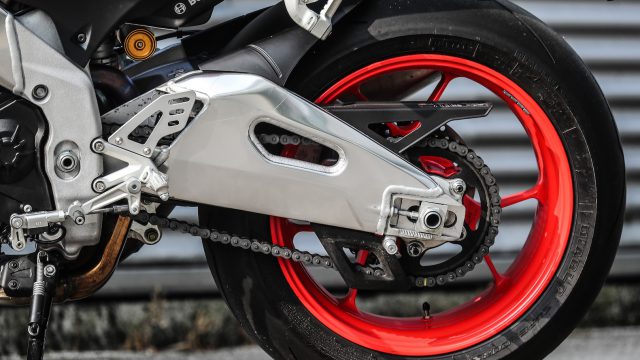
But as well as letting you set your TC and AWC for each different bend, after your ride is over the data logger that the V4-MP system incorporates shows real time speed, plus lean angle (certain to be a topic for bench racing in the pub after track days are ended!), throttle position and TC/anti-wheelie intervention, as well as showing you where you’re gaining or losing time lap by lap. Just takes time to understand and get used to, but here again Aprilia seems to be leading the field in yet another electronic riding aid’s development.
